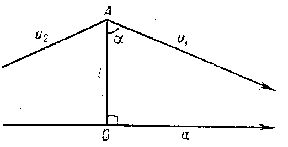Lobachevskii function
The angle of parallelism in Lobachevskii geometry is a function that expresses the angle  between the line
between the line  (or
(or  ) (see Fig.) and the segment
) (see Fig.) and the segment  perpendicular to a line
perpendicular to a line  parallel to
parallel to  (or
(or  ) in terms of the length
) in terms of the length  of the segment
of the segment  :
:
 |
where  is a positive constant that corresponds to the scale of measurement of distances.
is a positive constant that corresponds to the scale of measurement of distances.

Figure: l060020a
The Lobachevskii function is a continuous monotone decreasing function with values between  and 0:
and 0:
 |
It was introduced by N.I. Lobachevskii in 1826.
References
| [1] | V.F. Kagan, "Foundations of geometry" , 1 , Moscow-Leningrad (1949) (In Russian) |
| [2] | N.V. Efimov, "Höhere Geometrie" , Deutsch. Verlag Wissenschaft. (1960) (Translated from Russian) |
The special function (cf. Special functions) defined for real  by
by
 |
The Lobachevskii function can be represented as a series
 |
The main relations are:
 |
 |
 |
It was introduced by N.I. Lobachevskii in 1829.
References
| [1] | I.M. Ryzhik, I.S. Gradshtein, "Tables of integrals, series, and products" , Acad. Press (1980) (Translated from Russian) |
Comments
For the Lobachevskii function in the sense of 1) (i.e. the angle of parallelism) see also [a1]–[a4].
For Lobachevskii's function as defined in 2) see also [a5].
References
| [a1] | M. Greenberg, "Euclidean and non-Euclidean geometries" , Freeman (1974) |
| [a2] | H.S.M. Coxeter, "Parallel lines" Canad. Math. Bull. , 21 (1978) pp. 385–397 |
| [a3] | H.S.M. Coxeter, "Non-Euclidean geometry" , Univ. Toronto Press (1957) |
| [a4] | R. Bonola, "Non-Euclidean geometry" , Dover, reprint (1955) (Translated from Italian) |
| [a5] | H.S.M. Coxeter, "Twelve geometric esays" , Carbondale (1968) pp. Chapt. 1 |
Lobachevskii function. Encyclopedia of Mathematics. URL: http://encyclopediaofmath.org/index.php?title=Lobachevskii_function&oldid=15981